Running Launches
Topics:
- Overview
- Range Operations and Safety
- Insurance and Damages
- FAA Certificate of Waiver or Authorization
- Range Layout
- Related Documents
Overview
For almost all rocket clubs the first order of business is launching, and the first piece of club equipment will be a launcher. The least complex rocket firing range consists of nothing more than a single launch rod mounted on a sturdy base, a firing battery, some hook-up wire, and firing and safety interlock switches. Equipment of this type is available from the rocket manufacturers or can be home-built by one of the members. Such a firing system is fine for one or two model rocketeers, but an organized club will soon require a more elaborate firing range in order to avoid long delays between launches. At this point a decision must be made. The club members can elect to purchase or construct more individual launch systems and operate a “Misfire Alley” range, or a multiple position “Launch Rack” firing system can be constructed for model rockets. Sections that fly a lot of high power rockets will want a different kind of system, one that controls launching from a number of widely spaced and large pads a considerable distance away. Each system has its own advantages and disadvantages, so each Section should carefully consider its own needs and available resources before making the decision.
Range Operations and Safety
In all cases, as the launch operations expand and the Section becomes bigger, more rocketeers and spectators will be present on the range during firing operations. At this point, and when any high power rockets are launched, safety considerations dictate that there be a Range Safety Officer (RSO), who has overall responsibility for all activity on the range. The RSO must decide if the conditions are safe for a launching before the countdown can begin. He must be sure that:
- The model on the pad is safe for flight.
- The engine is a NAR Safety Certified type.
- The sky is clear of conflicting aircraft.
- The rocketeers and spectators are at a safe distance (see the safety code).
- The rocketeers and spectators are attentive to the fact that a rocket is about to be launched, before he allows the launch countdown to begin.
- Immediate fire hazards (tall grass, etc.) are cleared from the launch pad areas.
In addition, the RSO should ensure that certain “best practices” are followed when operating the range:
- Ensure that launch rods/rails are angled so that all flight paths (with weathercocking) result in trajectories that do not go over any spectators.
- Have a means of alerting everyone on the range of a dangerous situation (PA system, FM broadcast, air horn, etc.) so they can go “heads up”, but do not abuse the use of this for minor rocket malfunctions that do not represent a real danger.
- Know who to call or what to do in case of a personal injury or fire on the range.
- Ensure that immediate-action firefighting equipment is available and in working order in the launch area.
- Take prompt, definitive corrective action when a safety incident or “near miss” occurs; find the problem that caused the incident and correct it before flying continues.
Additional information is provided in the Related Documents below concerning how to conduct safety checkin for rockets and how to run a safe rocket range. Launch Safety is also covered in a whole section of the NAR website; this includes the NAR Safety Codes for model rocketry and high power rocketry. Competition rocketry including how to run a contest, is covered in a different section of the NAR website.
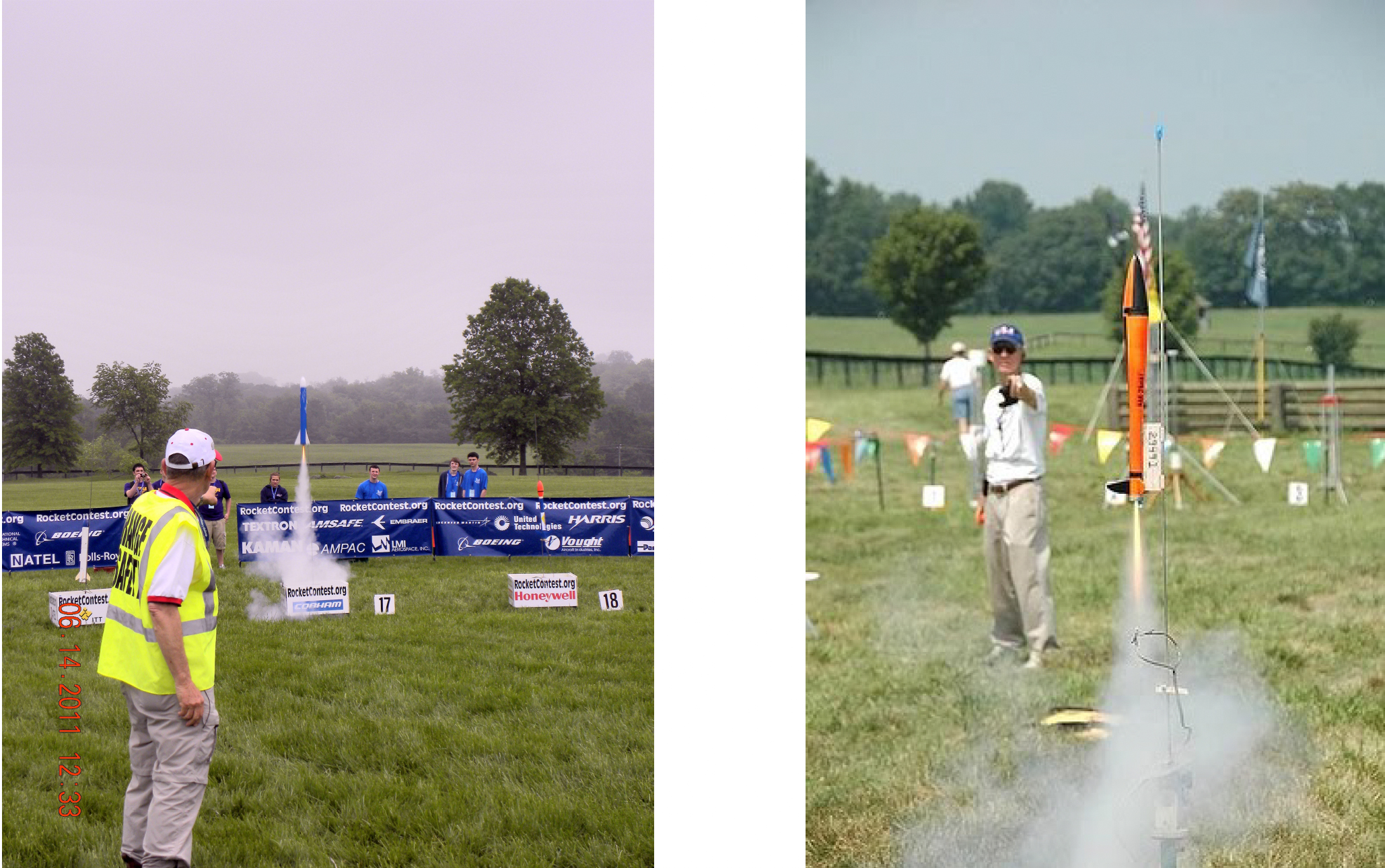
Insurance and Damages
Despite the best efforts of fliers to be safe and make rockets that work, and of RSO’s to run a safe range, sometimes accidents happen at rocket launches. These generally fall into two categories:
- a rocket hits something and damages it, generally during the recovery phase as the result of a failed recovery system.
- a rocket’s exhaust at launch, or ejection charge on landing after a crash, starts a grass fire.
By setting up the range with the spectator and parking areas crosswind from the launch area, and by angling the launch rods/rails slightly away from the spectator and parking area, the probability of impact damage is greatly reduced. If grass is cleared away from launch pads as required by the NAR Safety Codes, the probability of fire damage is greatly reduced; and with proper firefighting equipment readily at hand a fire can be stopped before it spreads.
If an incident happens that causes significant damage, the Section and the flier of the rocket causing the damage (if they are an NAR member) will both be covered by NAR insurance up to $5 million ($1 million for fire damage to the launch site). NAR insurance has a $5000 deductible (of which the member or Section is responsible for the first $1000), so it should not be used for minor claims for dents from rockets landing on cars under recovery systems. Some Sections make it quite clear to people attending their launches (fliers or spectators) that with respect to such minor damages they are attending at their own risk, and have them sign a “hold harmless” agreement such as the one in the Related Documents section below. The details of NAR Insurance are covered in a set of “frequently asked questions” on the NAR website.
FAA Certificate of Waiver or Authorization
If you plan to fly high-power rockets at your launch, you will have to get prior approval for each launch event from the Federal Aviation Administration. This approval is granted as a “waiver” to use the nation’s airspace, which the FAA controls. The FAA has exempted Class I Rockets (flight-ready rockets weighing 1500 grams or less and containing 125 grams or less of propellant) from requiring such prior approval. For larger rockets, you must apply for an FAA Certificate of Waiver or Authorization (CoA) using the procedures described on the NAR website.
The certificate will describe the Operations Authorized as well as any Special Provisions that you must follow in order to conduct launches. The Operation Authorized will typically be the launch of unmanned Class II Rockets at a defined location to a stated altitude during specified hours. The Special Provisions vary from certificate to certificate and usually contain instructions for the issuance of a Notice to Airman (NOTAM) as well as calls to FAA Air Traffic Control (ATC) facilities at specified before, during, and after launch operations.
The certificate provides us with the FAA’s approval to use the airspace. However, the airspace is not sanitized for our use nor does it provide us with the exclusive use. Pilots flying in the area should check for NOTAMs within their intended route of flight. The ATC will not vector IFR traffic through the waiver cylinder, and they will provide advisories to VFR traffic requesting flight path suggestions, but there is no expectation by the FAA that VFR pilots will avoid the area.
In general, pilots are governed by FAR 91.13, “Careless or reckless operation – No person may operate an aircraft in a careless or reckless manner so as to endanger the life or property of another.” Buzzing the launch area at low altitude or intentionally colliding with airborne rockets would be considered reckless, but simply flying into an area of unmanned rocket launching, or parachute jumping, or high terrain, is not reckless behavior. Per FAR 101.23 (a)(4) “You must operate an amateur rocket in such a manner that it does not create a hazard to persons, property, or other aircraft.”
The bottom line is that the responsibility for avoiding conflicts with manned aircraft rests with the launch officials.
Range Layout
Independent of the type of firing system employed, the basic range layout will remain the same (see figure below). The range itself is a large, open area relatively clear of trees and other obstacles. Its size depends on the power of the models to be flown, and a guide to field size can be found in the launch site dimension table following the NAR Safety Codes. Selection of a field of the recommended size or larger will not guarantee that all rockets with properly functioning recovery systems will land within the range area, but only that a malfunctioning rocket will not likely impact outside the recovery area should a recovery system failure occur.
The exact set-up of the “Firing Area” will depend on the type of launch system chosen. However, the Firing Area is generally located at the center of the range so that it does not have to be moved if the wind shifts during the launch session. On small fields the Firing Area may be located nearer the upwind edge of the range so that models will drift down over the range area. However, the Firing Area should never be located along the edge of the range area, to avoid problems caused by malfunctioning rockets impacting outside the range area. The designated Firing Area should be marked off with rope or flag line barriers at all launches where more than a few rocketeers or spectators will be present, to avoid the hazard of having an inattentive modeler or uninformed spectator wander into the Firing Area during a launching.
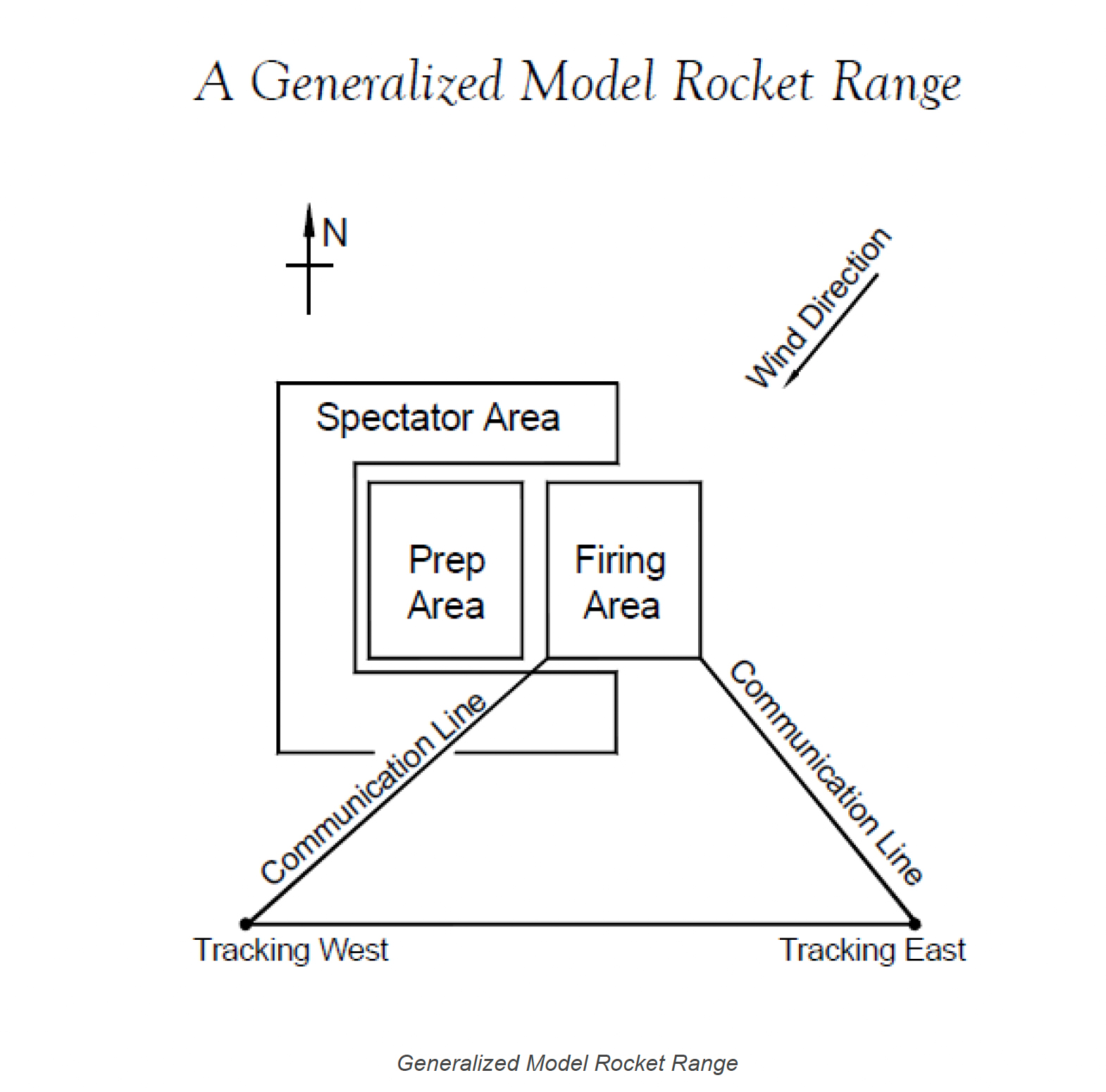
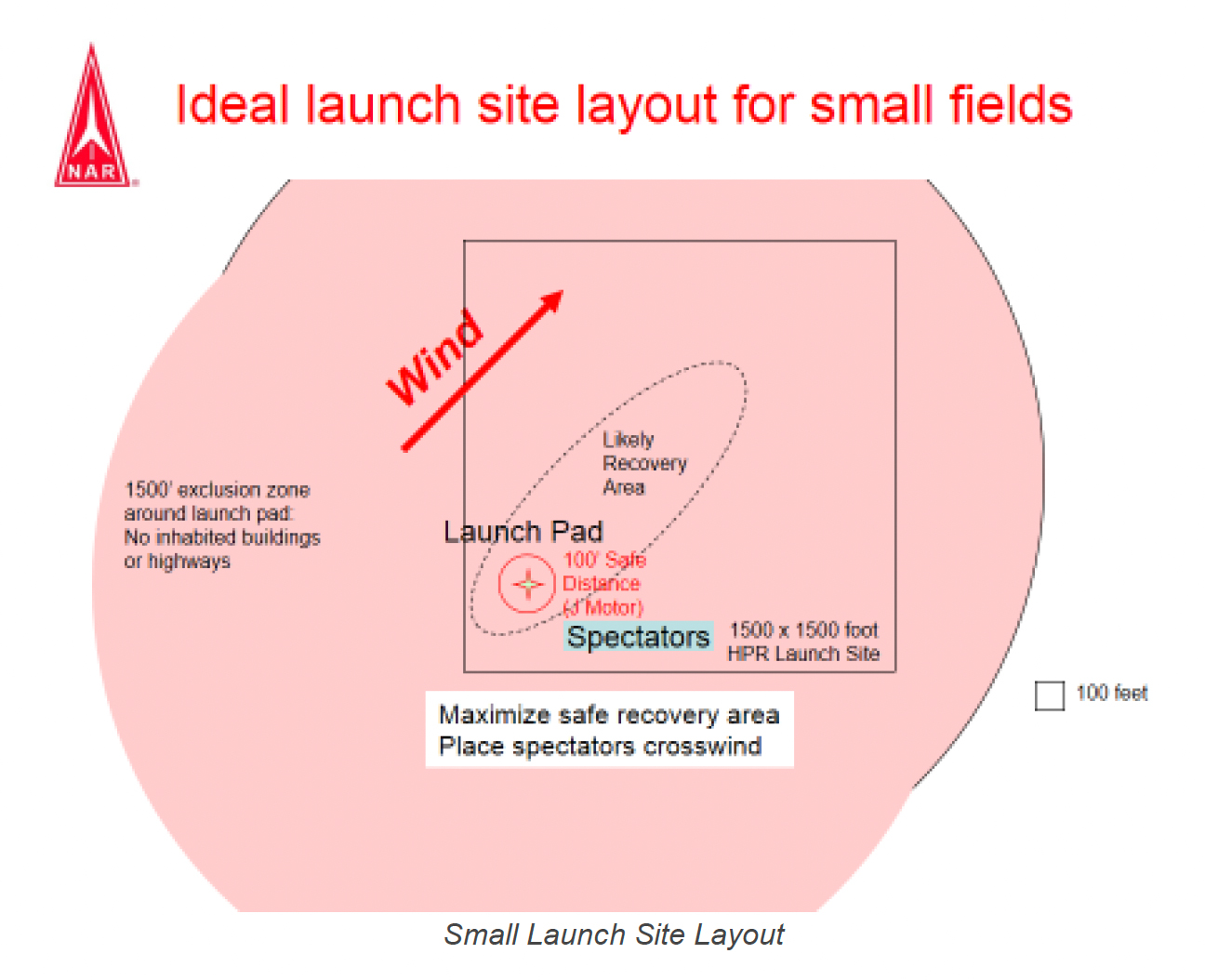 A Generalized Model Rocket Range
A Generalized Model Rocket Range
If the launch site is located in an area where large numbers of spectators would likely be (such as a public park) or if advance publicity makes it likely that there will be a large number of spectators, a specially roped off “Spectator Area” should be provided. For safety reasons, the Spectator Area should be crosswind from the Firing Area, not upwind (where weathercocking rockets with recovery failures will crash) or downwind (where rockets on recovery devices will be landing). Since spectators at rocket launches are already showing some interest in the hobby, a table with club information packets encouraging them to join your section can be located in the Spectator Area. A club member should wander through the Spectator Area occasionally, answering questions, explaining model rocket safety, and promoting your Section.
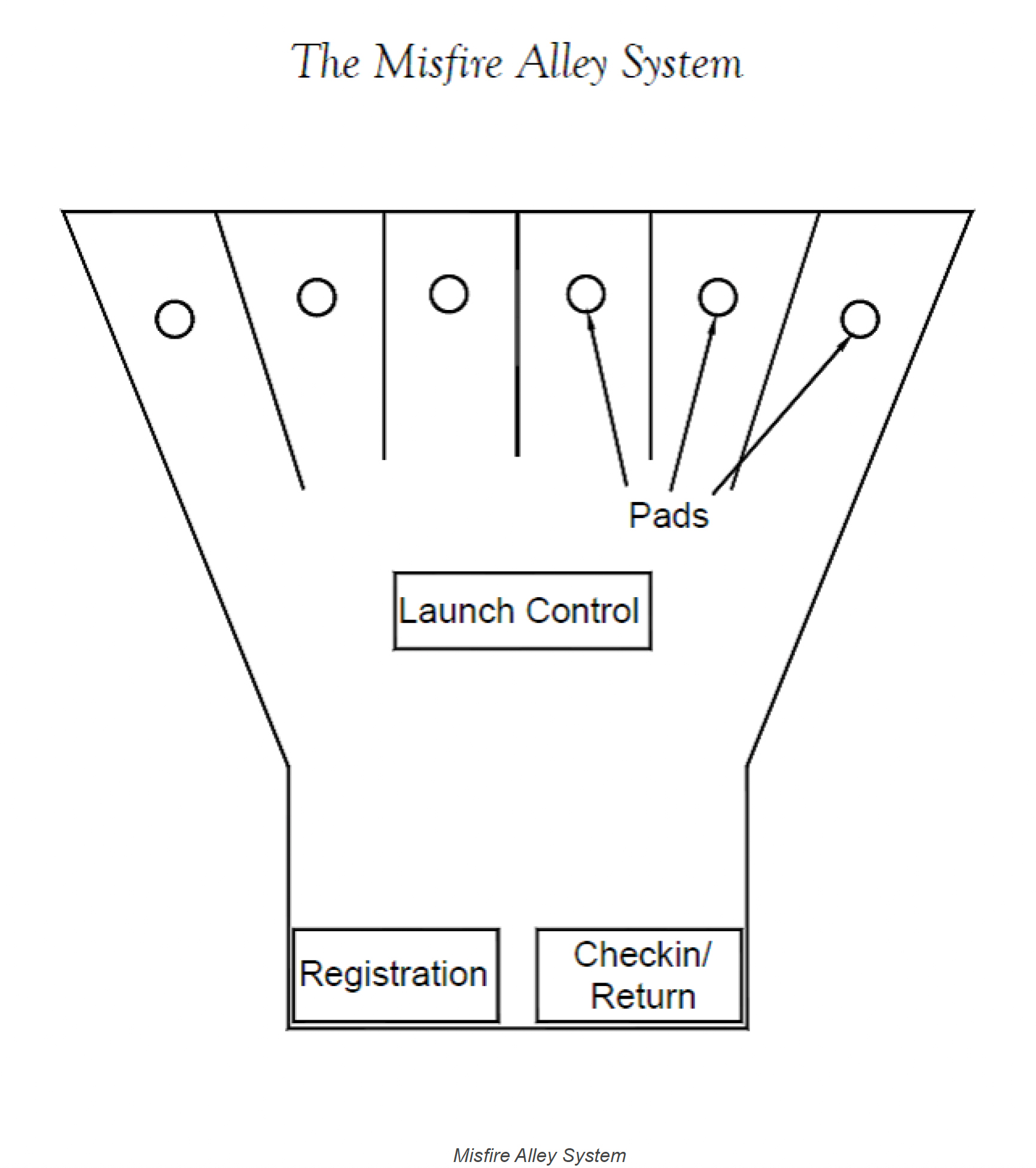
Misfire Alley Range
The Misfire Alley system is an “individual responsibility” system for model rocket ranges. Everyone who wants to fly at the launch provides his own personal launcher, firing system, and firing battery; or he arranges to use the system provided by another club member. Each participant sets up his own launch system in an area designated by the RSO. Usually the launching stations are placed in a straight line or U-shaped arrangement, with each launch pad located at least 5 meters from the next one. A large sign adjacent to each launcher designates the launching station by number. Each participant is free to prepare his own models for flight in the area of his launching station, without interference from other participants. Since he is located at least 5 meters from the next nearest launcher, he may continue preparing his model while other rockets (D powered or below) are being launched. When large models are being flown, the RSO may require that all persons on the range stand and observe the flight path in order that they will be immediately aware of any malfunction, and that rocketeers in adjacent firing stations leave their areas during the actual firing.
The RSO conducts range operations from the center table and each pad functions independently under his control. The RSO, who is centrally located and has a clear view of all participants, spectators, and launching stations, as well as the area surrounding the range, gives a range safety clearance by announcing to all participants “Pad number 5 is clear to launch.” The modeler at station 5 then arms his firing system, either he or the RSO gives an audible 5 second countdown, and the modeler launches his rocket.
The only range equipment which the Section must supply is a public address system or bullhorn for the RSO, so that his announcements may be heard by everyone on the range, numbered signs for each launching station, and a barrier to keep spectators out of the Firing Area. None of this equipment is expensive, difficult to build, or difficult to transport, and it requires virtually no maintenance. The Misfire Alley system avoids the problem of appointing a Section member to keep the firing panel and launch racks in good shape. Each rocketeer is responsible for keeping his own launch system in working order, and he has only himself to blame if it fails to function properly. However, a disadvantage of the Misfire Alley system is that it requires each rocketeer to purchase his own launch system, thus taking away some of the monetary advantage of joining a club to save his money.
A small Section whose members already own simple launch systems should certainly consider the misfire alley system, especially during the early growth stages of the club. Some larger Sections have also found that this system meets their needs. Other Sections find that the launch rack system is more suitable when membership increases or for large contests where rocketeers will be traveling on public transportation and carrying a personal launch system would be inconvenient.
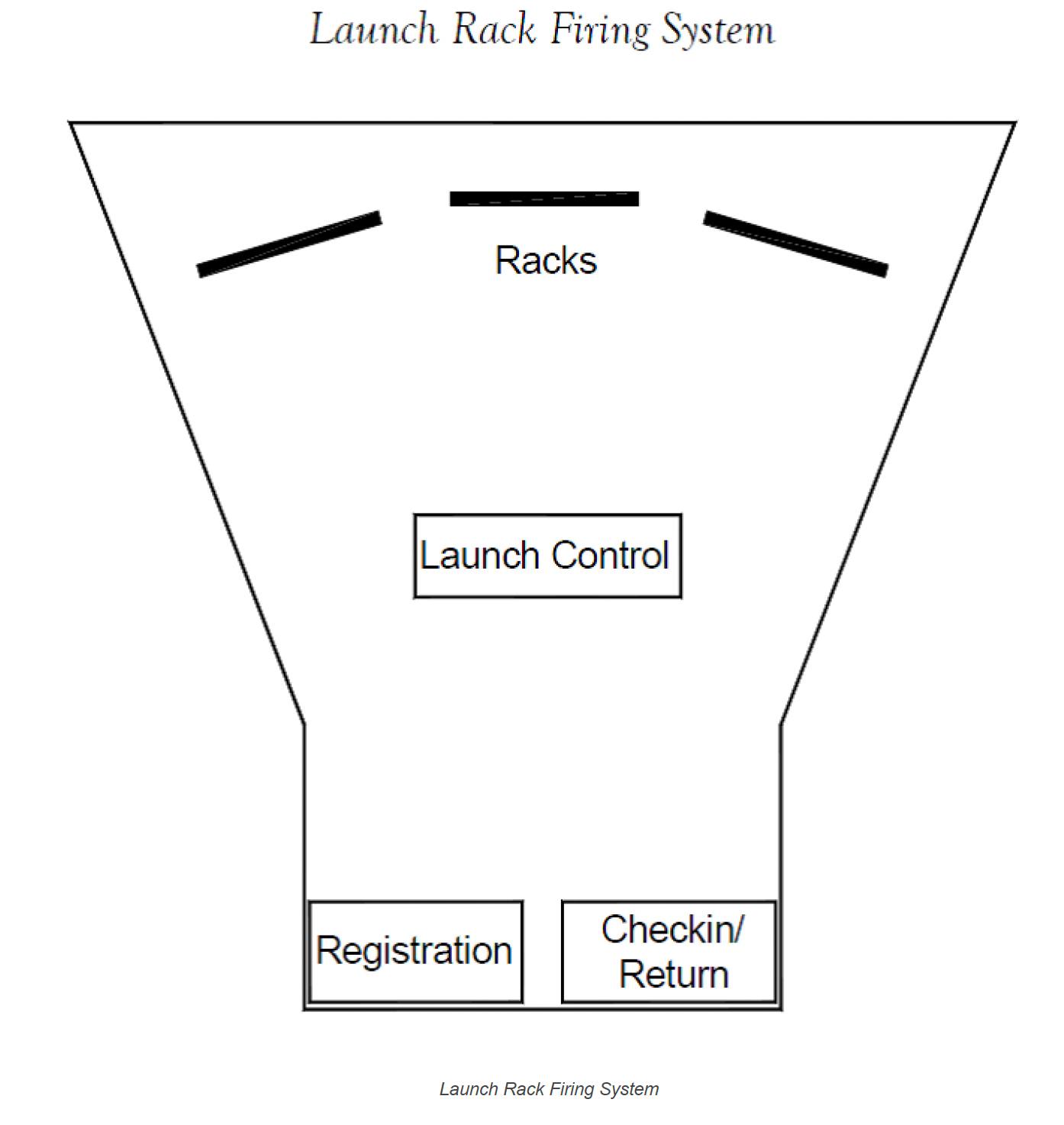
Launch Rack System
The Launch Rack System for model rocket ranges attracts new rocketeers to the Section by allowing them to get involved in the hobby without investing in their own launch system. A single rack, consisting of nothing more than a wood sawhorse with holes drilled in the crossbar to accept 6 or 8 1/8” x 36” launch rods, will not require a great financial investment on the part of the club. A firing panel, with individual launch cables running from the battery through a firing switch on the panel to each launch position on the rack can also be easily constructed at low cost from parts available at any electronics supply store.
High Power Launch Range
Class II High Power Rockets are those that have a flight-ready weight of more than 1500 grams (3.3 pounds), or are powered by motors that containing more than 125 grams (4.4 ounces), or that are powered by a “sparky” or hybrid rocket motor. The launch equipment that they require is proportional to their size — large and heavy. The launchers are all for single rockets, have heavy steel bases with widely-spread legs, and typically use rails 6 to 12 feet in length rather than rods. The minimum safe distance that the LCO, RSO and spectators must be away from any active launch pad is 100 feet (for J motors and below), and the distance progressively increases with the installed motor impulse. Depending upon the launch control type, significant amounts of wire may be required from the controller location to each launch pad. The launchers are usually set up in rows, a few tens of feet apart and spaced at 100 feet from the launch point (for H through J powered rockets), 200 feet (K powered rockets or rockets with multiple motors of lower power classes), 300 feet (L power) and “away”, or 500 feet, for larger rockets. See the “Running a Big Rocket Range” file in the Related Documents below for more details on how to set up a high-power range.
Running a high power range requires a significant investment in heavy capital equipment in addition to very careful attention to safety given the large size and high energy of these rockets. Rigorous pre-flight inspection at checkin by an experienced high-power-certified NAR member is essential to safety. And of course an FAA Certificate of Waiver or Authorization for use of the airspace is required. For all these reasons, people tend to band together in Sections in order to purchase, set up, and operate such a range.
Other Range Features
As the number of rocketeers and spectators attending your launches increases, many other additions can be made to make your range more comfortable and convenient to use. When running a contest, a bulletin board can be used to post up-to-the-minute contest results. This allows participants to know what performance they must beat in order to move into first place, and allows spectators to get more involved in the excitement of the contest.
A “Range Store” selling various rocketry supplies is a great convenience for the modeler who forgets something, or needs to make an on-the-field repair. If the Section already maintains its own supply of parts and engines for sale to its members, this “store” can be brought out to the range and manned by club members during the flying session. For large gatherings, the local hobby shop or one of the numerous traveling rocketry vendors may be agreeable to the idea of bringing out a trailer full of rocket supplies to sell on the range.
A refreshment stand, with cold soda in summer and hot chocolate in winter, can also be a profitable operation for your Section. At all-day launches, or weekend regionals, you can add snacks or sandwiches if there is no restaurant within easy traveling distance of the range. At each launch you will discover more little things you could add to the range to make its operation more fun.
Related Documents:
| NAR Launch Hold Harmless Release | Other | May 27, 2014, 10:18 pm | 25 KB |
| Range Safety Check Guidelines | May 27, 2014, 10:18 pm | 20 KB | |
| RSO Operations Manual - Blue Mtn Rktrs | May 27, 2014, 10:18 pm | 61 KB | |
| Running a Big Rocket Range | May 27, 2014, 10:18 pm | 31 KB | |
| Safety Training for RSO (2013) | May 27, 2014, 10:18 pm | 2 MB | |
| Safety in High Power Rocketry Presentation | March 12, 2017, 4:04 am | 3 MB |